Stakeholder Engagement in CSR: Oil and Gas Sector in Australia Report
VerifiedAdded on 2023/06/08
|12
|2253
|133
Report
AI Summary
This report delves into the critical role of stakeholder engagement in achieving corporate environmental sustainability, particularly within the oil and gas sector in Australia. The report begins with an introduction highlighting the significance of stakeholder involvement in CSR, followed by a discussion of the background of a project manager facing challenges in securing resources for environmental maintenance. It then outlines the objectives of the learning project, which include understanding stakeholder types, identifying project outcomes, and developing strategies to mitigate challenges. The methodology section describes the process of stakeholder engagement, including review, assessment, and resolution. The report also addresses challenges such as time consumption, slow decision-making, and access to stakeholders. Through an analysis of the stakeholder engagement process, the report concludes by emphasizing the importance of stakeholder engagement in fostering a better environment for addressing corporate environmental sustainability issues. The report provides recommendations and insights for future project designs within the sector. The report also includes references to support the research.
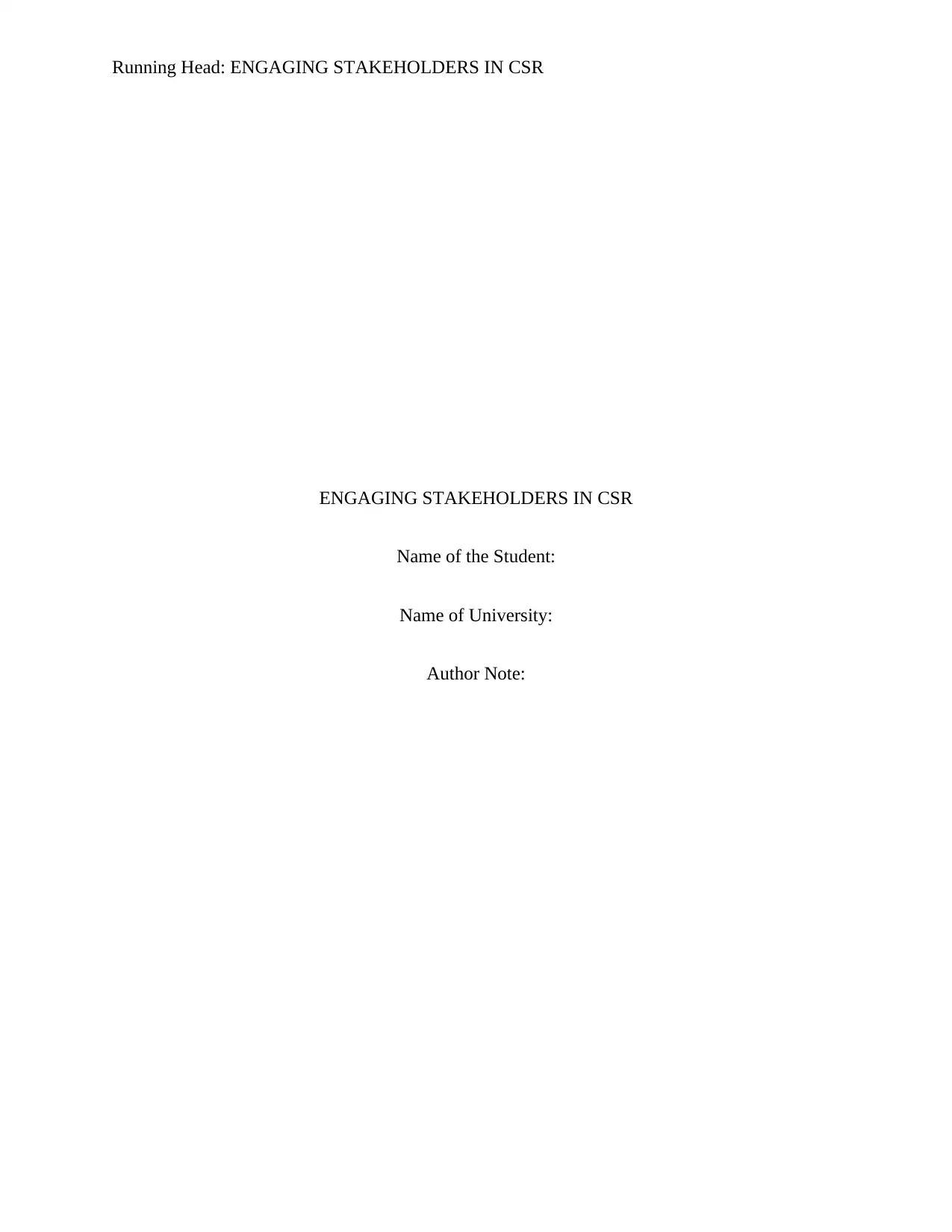
Running Head: ENGAGING STAKEHOLDERS IN CSR
ENGAGING STAKEHOLDERS IN CSR
Name of the Student:
Name of University:
Author Note:
ENGAGING STAKEHOLDERS IN CSR
Name of the Student:
Name of University:
Author Note:
Paraphrase This Document
Need a fresh take? Get an instant paraphrase of this document with our AI Paraphraser
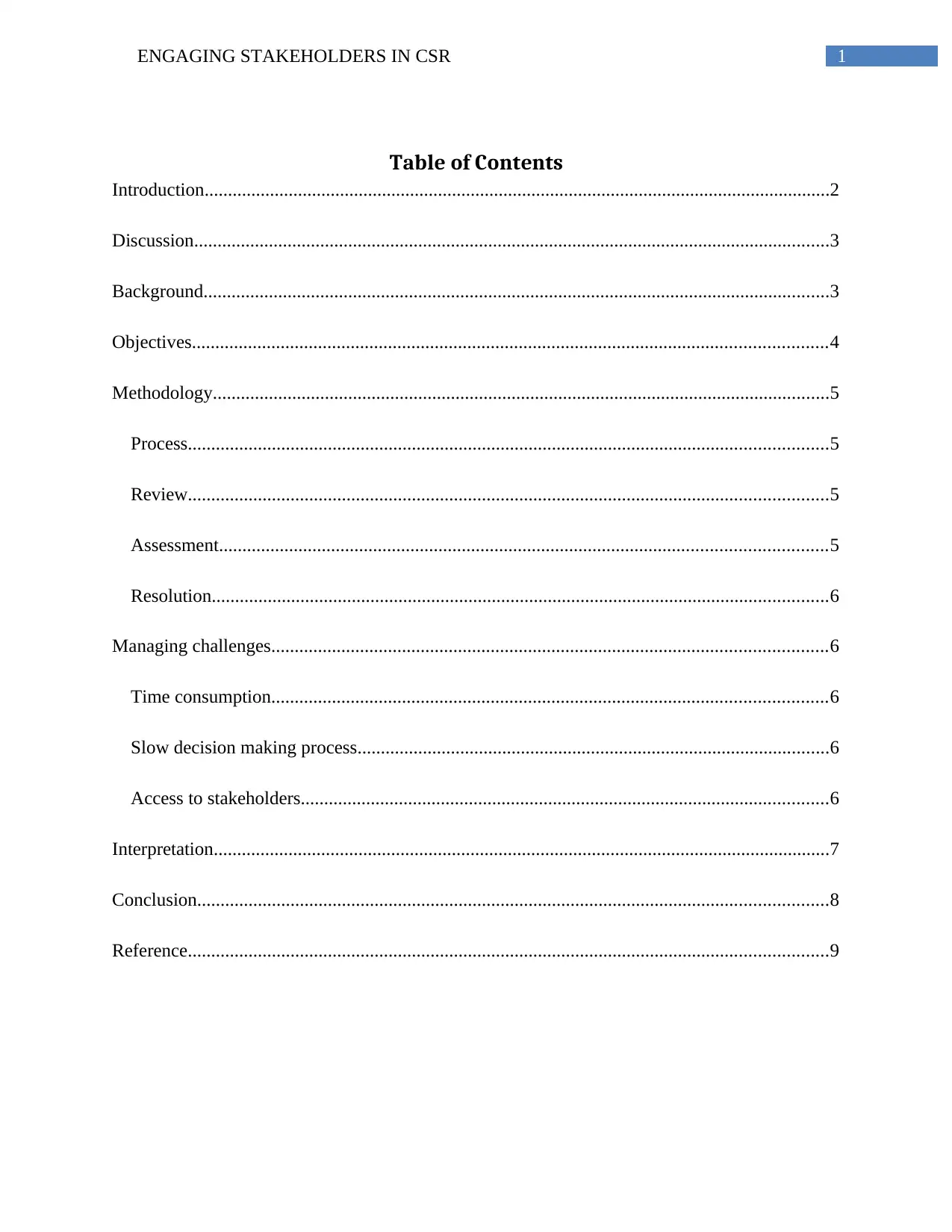
1ENGAGING STAKEHOLDERS IN CSR
Table of Contents
Introduction......................................................................................................................................2
Discussion........................................................................................................................................3
Background......................................................................................................................................3
Objectives........................................................................................................................................4
Methodology....................................................................................................................................5
Process.........................................................................................................................................5
Review.........................................................................................................................................5
Assessment..................................................................................................................................5
Resolution....................................................................................................................................6
Managing challenges.......................................................................................................................6
Time consumption.......................................................................................................................6
Slow decision making process.....................................................................................................6
Access to stakeholders.................................................................................................................6
Interpretation....................................................................................................................................7
Conclusion.......................................................................................................................................8
Reference.........................................................................................................................................9
Table of Contents
Introduction......................................................................................................................................2
Discussion........................................................................................................................................3
Background......................................................................................................................................3
Objectives........................................................................................................................................4
Methodology....................................................................................................................................5
Process.........................................................................................................................................5
Review.........................................................................................................................................5
Assessment..................................................................................................................................5
Resolution....................................................................................................................................6
Managing challenges.......................................................................................................................6
Time consumption.......................................................................................................................6
Slow decision making process.....................................................................................................6
Access to stakeholders.................................................................................................................6
Interpretation....................................................................................................................................7
Conclusion.......................................................................................................................................8
Reference.........................................................................................................................................9

2ENGAGING STAKEHOLDERS IN CSR
⊘ This is a preview!⊘
Do you want full access?
Subscribe today to unlock all pages.

Trusted by 1+ million students worldwide
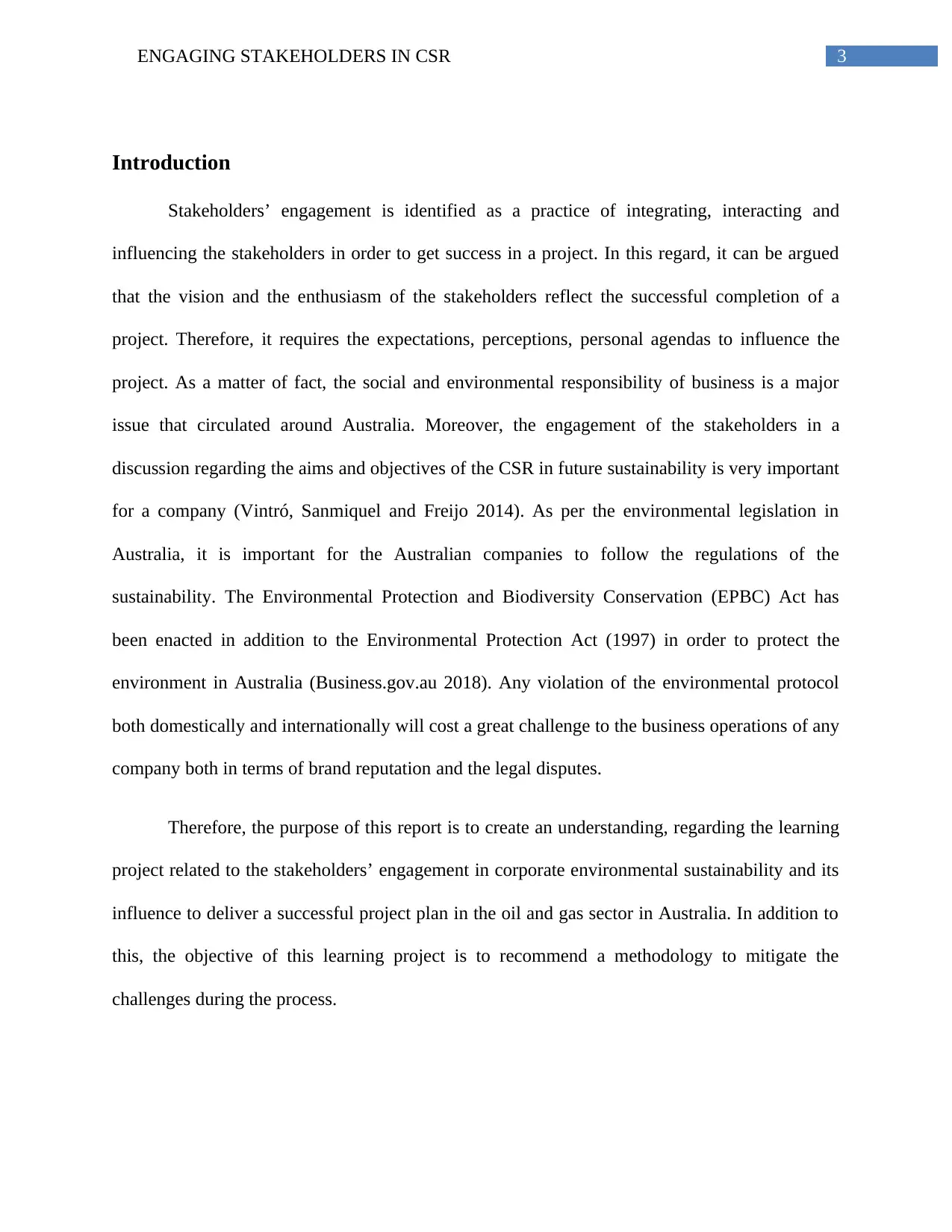
3ENGAGING STAKEHOLDERS IN CSR
Introduction
Stakeholders’ engagement is identified as a practice of integrating, interacting and
influencing the stakeholders in order to get success in a project. In this regard, it can be argued
that the vision and the enthusiasm of the stakeholders reflect the successful completion of a
project. Therefore, it requires the expectations, perceptions, personal agendas to influence the
project. As a matter of fact, the social and environmental responsibility of business is a major
issue that circulated around Australia. Moreover, the engagement of the stakeholders in a
discussion regarding the aims and objectives of the CSR in future sustainability is very important
for a company (Vintró, Sanmiquel and Freijo 2014). As per the environmental legislation in
Australia, it is important for the Australian companies to follow the regulations of the
sustainability. The Environmental Protection and Biodiversity Conservation (EPBC) Act has
been enacted in addition to the Environmental Protection Act (1997) in order to protect the
environment in Australia (Business.gov.au 2018). Any violation of the environmental protocol
both domestically and internationally will cost a great challenge to the business operations of any
company both in terms of brand reputation and the legal disputes.
Therefore, the purpose of this report is to create an understanding, regarding the learning
project related to the stakeholders’ engagement in corporate environmental sustainability and its
influence to deliver a successful project plan in the oil and gas sector in Australia. In addition to
this, the objective of this learning project is to recommend a methodology to mitigate the
challenges during the process.
Introduction
Stakeholders’ engagement is identified as a practice of integrating, interacting and
influencing the stakeholders in order to get success in a project. In this regard, it can be argued
that the vision and the enthusiasm of the stakeholders reflect the successful completion of a
project. Therefore, it requires the expectations, perceptions, personal agendas to influence the
project. As a matter of fact, the social and environmental responsibility of business is a major
issue that circulated around Australia. Moreover, the engagement of the stakeholders in a
discussion regarding the aims and objectives of the CSR in future sustainability is very important
for a company (Vintró, Sanmiquel and Freijo 2014). As per the environmental legislation in
Australia, it is important for the Australian companies to follow the regulations of the
sustainability. The Environmental Protection and Biodiversity Conservation (EPBC) Act has
been enacted in addition to the Environmental Protection Act (1997) in order to protect the
environment in Australia (Business.gov.au 2018). Any violation of the environmental protocol
both domestically and internationally will cost a great challenge to the business operations of any
company both in terms of brand reputation and the legal disputes.
Therefore, the purpose of this report is to create an understanding, regarding the learning
project related to the stakeholders’ engagement in corporate environmental sustainability and its
influence to deliver a successful project plan in the oil and gas sector in Australia. In addition to
this, the objective of this learning project is to recommend a methodology to mitigate the
challenges during the process.
Paraphrase This Document
Need a fresh take? Get an instant paraphrase of this document with our AI Paraphraser
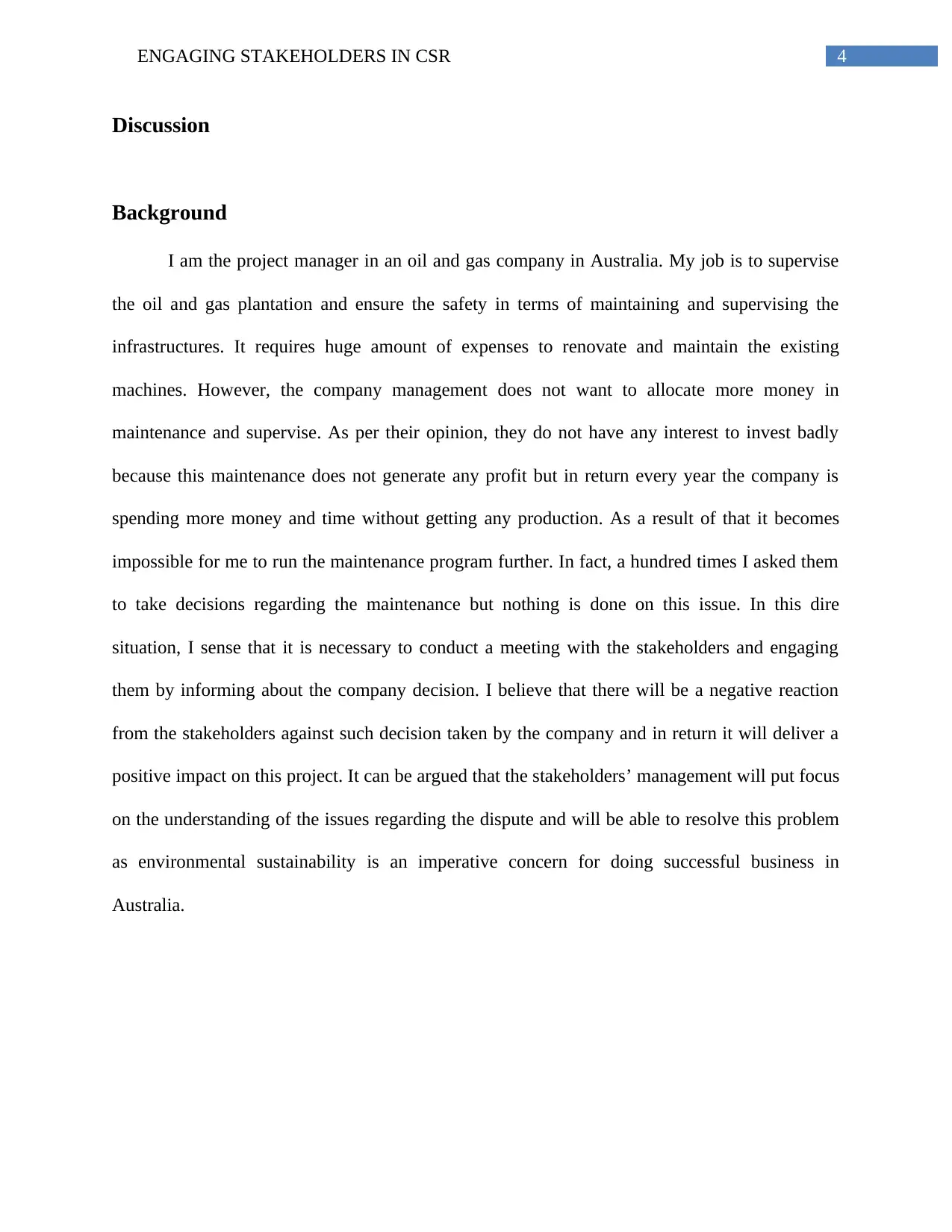
4ENGAGING STAKEHOLDERS IN CSR
Discussion
Background
I am the project manager in an oil and gas company in Australia. My job is to supervise
the oil and gas plantation and ensure the safety in terms of maintaining and supervising the
infrastructures. It requires huge amount of expenses to renovate and maintain the existing
machines. However, the company management does not want to allocate more money in
maintenance and supervise. As per their opinion, they do not have any interest to invest badly
because this maintenance does not generate any profit but in return every year the company is
spending more money and time without getting any production. As a result of that it becomes
impossible for me to run the maintenance program further. In fact, a hundred times I asked them
to take decisions regarding the maintenance but nothing is done on this issue. In this dire
situation, I sense that it is necessary to conduct a meeting with the stakeholders and engaging
them by informing about the company decision. I believe that there will be a negative reaction
from the stakeholders against such decision taken by the company and in return it will deliver a
positive impact on this project. It can be argued that the stakeholders’ management will put focus
on the understanding of the issues regarding the dispute and will be able to resolve this problem
as environmental sustainability is an imperative concern for doing successful business in
Australia.
Discussion
Background
I am the project manager in an oil and gas company in Australia. My job is to supervise
the oil and gas plantation and ensure the safety in terms of maintaining and supervising the
infrastructures. It requires huge amount of expenses to renovate and maintain the existing
machines. However, the company management does not want to allocate more money in
maintenance and supervise. As per their opinion, they do not have any interest to invest badly
because this maintenance does not generate any profit but in return every year the company is
spending more money and time without getting any production. As a result of that it becomes
impossible for me to run the maintenance program further. In fact, a hundred times I asked them
to take decisions regarding the maintenance but nothing is done on this issue. In this dire
situation, I sense that it is necessary to conduct a meeting with the stakeholders and engaging
them by informing about the company decision. I believe that there will be a negative reaction
from the stakeholders against such decision taken by the company and in return it will deliver a
positive impact on this project. It can be argued that the stakeholders’ management will put focus
on the understanding of the issues regarding the dispute and will be able to resolve this problem
as environmental sustainability is an imperative concern for doing successful business in
Australia.

5ENGAGING STAKEHOLDERS IN CSR
Objectives
The purpose of this part is not to deal with the objectives of the stakeholders’ engagement
program rather focusing on the aims of the learning project. Therefore, the objectives are as
follows:
To get a clear understanding of the types of stakeholders those who are engaged in the
process of re-establishing corporate environmental sustainability in the company that is
directly related to my role in the company (Larmer, Mergendoller and Boss 2015).
To figure out the possible outcome of the project in order to analyse the critical elements
in stakeholder engagement. The outcome is related to the positive impacts and crucial
result of the learning project (Eynon, Gambino and Török 2014).
To learn the possible steps to mitigate the problem related to protect the corporate
environment sustainability.
Develop confidence in order to design the stakeholder engagement in the future design
progress (Abele et al. 2015).
To learn the principles those are stapled with the participation of the stakeholder in the
activity.
To learn which tools and techniques will be implemented in order to make the
engagement more effective and efficient (Boss and Krauss 2014).
To learn the communication methods that is going to be used in the stakeholder
engagement process (Arcidiacono et al. 2016).
Objectives
The purpose of this part is not to deal with the objectives of the stakeholders’ engagement
program rather focusing on the aims of the learning project. Therefore, the objectives are as
follows:
To get a clear understanding of the types of stakeholders those who are engaged in the
process of re-establishing corporate environmental sustainability in the company that is
directly related to my role in the company (Larmer, Mergendoller and Boss 2015).
To figure out the possible outcome of the project in order to analyse the critical elements
in stakeholder engagement. The outcome is related to the positive impacts and crucial
result of the learning project (Eynon, Gambino and Török 2014).
To learn the possible steps to mitigate the problem related to protect the corporate
environment sustainability.
Develop confidence in order to design the stakeholder engagement in the future design
progress (Abele et al. 2015).
To learn the principles those are stapled with the participation of the stakeholder in the
activity.
To learn which tools and techniques will be implemented in order to make the
engagement more effective and efficient (Boss and Krauss 2014).
To learn the communication methods that is going to be used in the stakeholder
engagement process (Arcidiacono et al. 2016).
⊘ This is a preview!⊘
Do you want full access?
Subscribe today to unlock all pages.

Trusted by 1+ million students worldwide
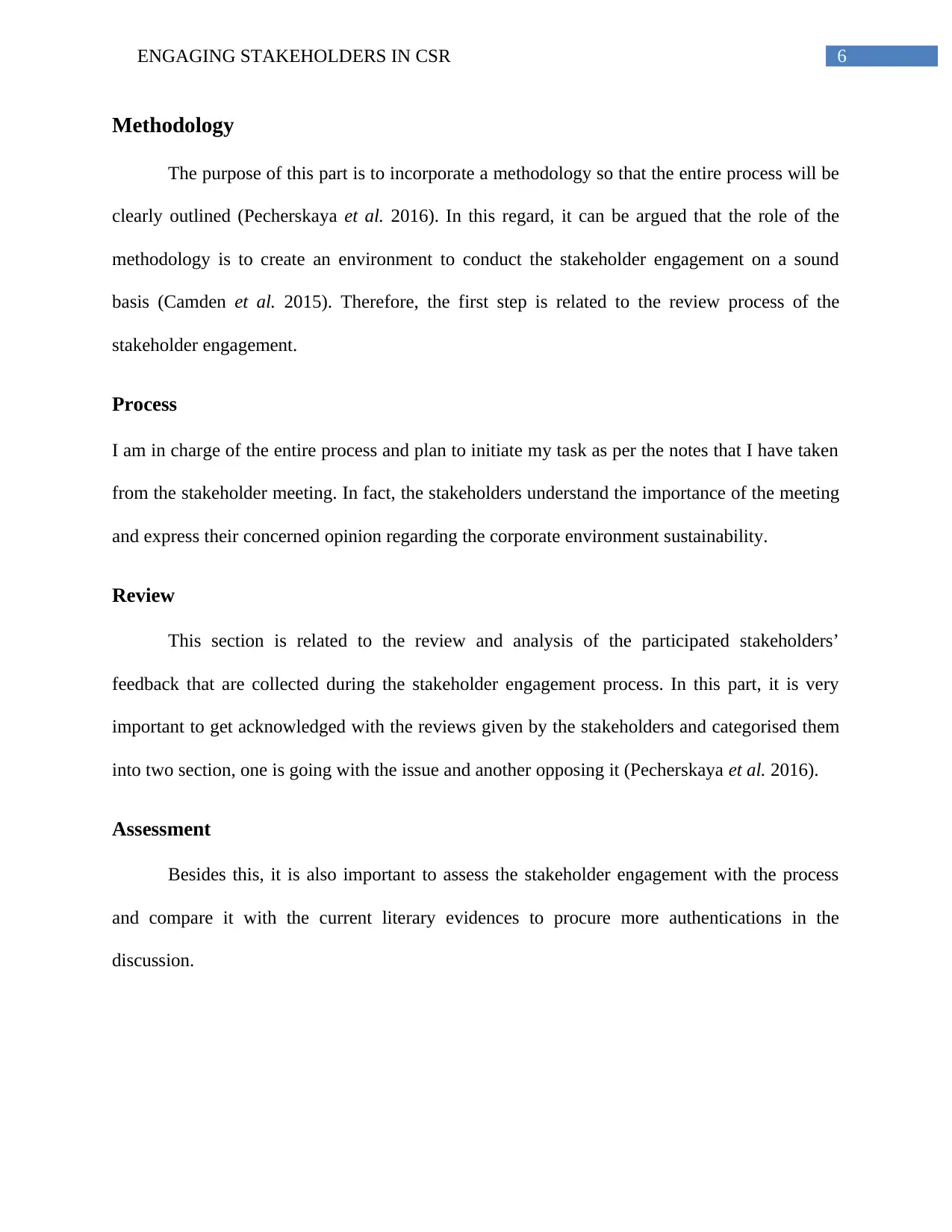
6ENGAGING STAKEHOLDERS IN CSR
Methodology
The purpose of this part is to incorporate a methodology so that the entire process will be
clearly outlined (Pecherskaya et al. 2016). In this regard, it can be argued that the role of the
methodology is to create an environment to conduct the stakeholder engagement on a sound
basis (Camden et al. 2015). Therefore, the first step is related to the review process of the
stakeholder engagement.
Process
I am in charge of the entire process and plan to initiate my task as per the notes that I have taken
from the stakeholder meeting. In fact, the stakeholders understand the importance of the meeting
and express their concerned opinion regarding the corporate environment sustainability.
Review
This section is related to the review and analysis of the participated stakeholders’
feedback that are collected during the stakeholder engagement process. In this part, it is very
important to get acknowledged with the reviews given by the stakeholders and categorised them
into two section, one is going with the issue and another opposing it (Pecherskaya et al. 2016).
Assessment
Besides this, it is also important to assess the stakeholder engagement with the process
and compare it with the current literary evidences to procure more authentications in the
discussion.
Methodology
The purpose of this part is to incorporate a methodology so that the entire process will be
clearly outlined (Pecherskaya et al. 2016). In this regard, it can be argued that the role of the
methodology is to create an environment to conduct the stakeholder engagement on a sound
basis (Camden et al. 2015). Therefore, the first step is related to the review process of the
stakeholder engagement.
Process
I am in charge of the entire process and plan to initiate my task as per the notes that I have taken
from the stakeholder meeting. In fact, the stakeholders understand the importance of the meeting
and express their concerned opinion regarding the corporate environment sustainability.
Review
This section is related to the review and analysis of the participated stakeholders’
feedback that are collected during the stakeholder engagement process. In this part, it is very
important to get acknowledged with the reviews given by the stakeholders and categorised them
into two section, one is going with the issue and another opposing it (Pecherskaya et al. 2016).
Assessment
Besides this, it is also important to assess the stakeholder engagement with the process
and compare it with the current literary evidences to procure more authentications in the
discussion.
Paraphrase This Document
Need a fresh take? Get an instant paraphrase of this document with our AI Paraphraser

7ENGAGING STAKEHOLDERS IN CSR
Resolution
After going through a thorough analysis and understanding regarding the stakeholder
engagement in the corporate environmental sustainability, it is important to take necessary steps
regarding the decision made by the stakeholders.
Managing challenges
However, there are some challenges that the company can face during engaging the
stakeholders. The challenges are as follows:
Time consumption
Engaging the stakeholders can be identified as a time consuming process that the
company must keep in mind. It is obvious that the company may have a number of stakeholders
and managing and engaging them is not an easy task (Henisz 2017). Therefore, during the
stakeholder engagement, it always takes time to manage all of them. Therefore, implementing a
better communication plan is very important for the company to be developed.
Slow decision making process
The decision making process is not so fast to implement. Therefore, in case of dire
situation it will be very problematic to engage all the stakeholders because there is limited time
for the company to mitigate the problem as fast as they can (Luoma-aho 2015). As a result of
that it is imperative to inform the stakeholders about any development on a daily basis.
Access to stakeholders
Due to huge numbers of the Stakeholders strength it is impossible to manage them
equally (Caputo 2016). In addition to this, there are several layers that I have to go through to
Resolution
After going through a thorough analysis and understanding regarding the stakeholder
engagement in the corporate environmental sustainability, it is important to take necessary steps
regarding the decision made by the stakeholders.
Managing challenges
However, there are some challenges that the company can face during engaging the
stakeholders. The challenges are as follows:
Time consumption
Engaging the stakeholders can be identified as a time consuming process that the
company must keep in mind. It is obvious that the company may have a number of stakeholders
and managing and engaging them is not an easy task (Henisz 2017). Therefore, during the
stakeholder engagement, it always takes time to manage all of them. Therefore, implementing a
better communication plan is very important for the company to be developed.
Slow decision making process
The decision making process is not so fast to implement. Therefore, in case of dire
situation it will be very problematic to engage all the stakeholders because there is limited time
for the company to mitigate the problem as fast as they can (Luoma-aho 2015). As a result of
that it is imperative to inform the stakeholders about any development on a daily basis.
Access to stakeholders
Due to huge numbers of the Stakeholders strength it is impossible to manage them
equally (Caputo 2016). In addition to this, there are several layers that I have to go through to
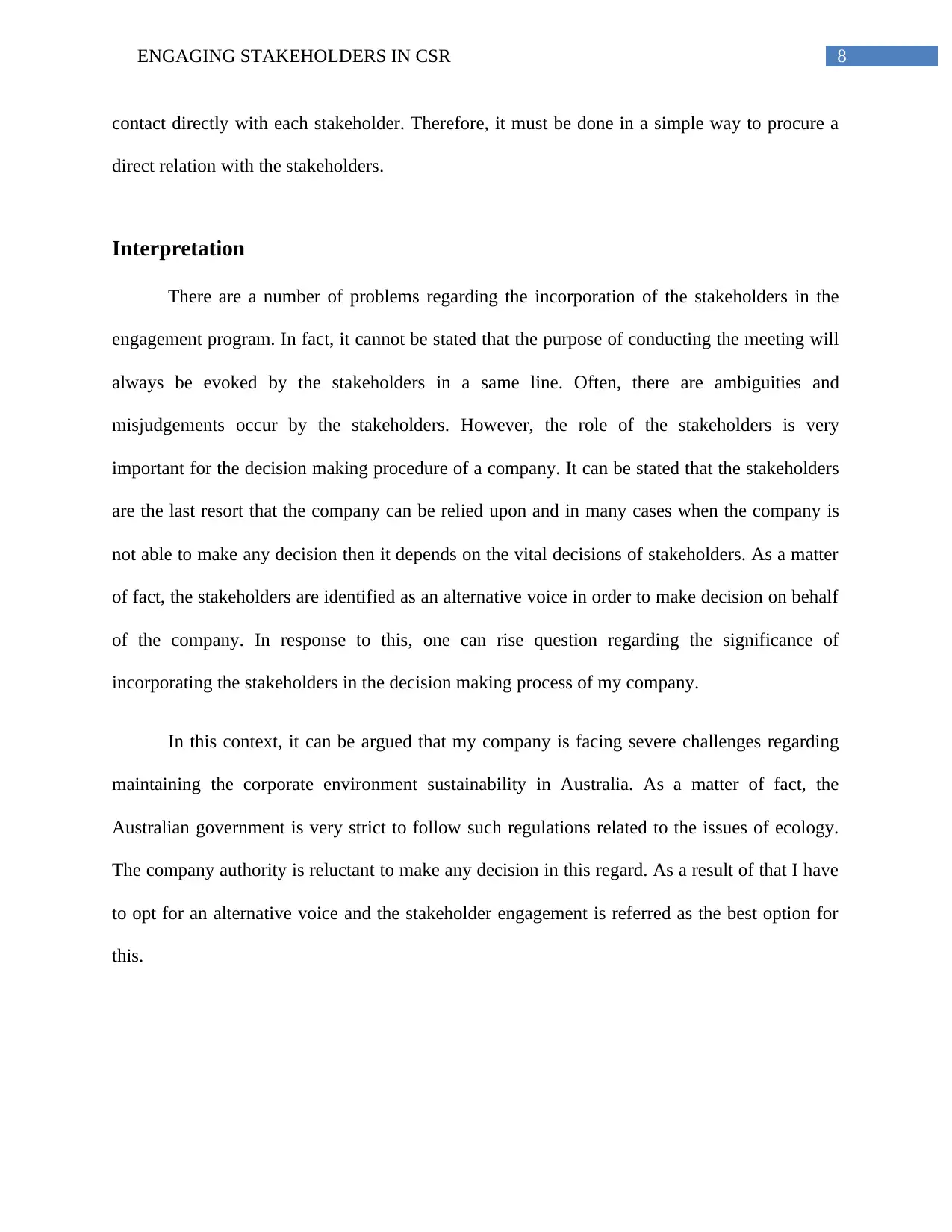
8ENGAGING STAKEHOLDERS IN CSR
contact directly with each stakeholder. Therefore, it must be done in a simple way to procure a
direct relation with the stakeholders.
Interpretation
There are a number of problems regarding the incorporation of the stakeholders in the
engagement program. In fact, it cannot be stated that the purpose of conducting the meeting will
always be evoked by the stakeholders in a same line. Often, there are ambiguities and
misjudgements occur by the stakeholders. However, the role of the stakeholders is very
important for the decision making procedure of a company. It can be stated that the stakeholders
are the last resort that the company can be relied upon and in many cases when the company is
not able to make any decision then it depends on the vital decisions of stakeholders. As a matter
of fact, the stakeholders are identified as an alternative voice in order to make decision on behalf
of the company. In response to this, one can rise question regarding the significance of
incorporating the stakeholders in the decision making process of my company.
In this context, it can be argued that my company is facing severe challenges regarding
maintaining the corporate environment sustainability in Australia. As a matter of fact, the
Australian government is very strict to follow such regulations related to the issues of ecology.
The company authority is reluctant to make any decision in this regard. As a result of that I have
to opt for an alternative voice and the stakeholder engagement is referred as the best option for
this.
contact directly with each stakeholder. Therefore, it must be done in a simple way to procure a
direct relation with the stakeholders.
Interpretation
There are a number of problems regarding the incorporation of the stakeholders in the
engagement program. In fact, it cannot be stated that the purpose of conducting the meeting will
always be evoked by the stakeholders in a same line. Often, there are ambiguities and
misjudgements occur by the stakeholders. However, the role of the stakeholders is very
important for the decision making procedure of a company. It can be stated that the stakeholders
are the last resort that the company can be relied upon and in many cases when the company is
not able to make any decision then it depends on the vital decisions of stakeholders. As a matter
of fact, the stakeholders are identified as an alternative voice in order to make decision on behalf
of the company. In response to this, one can rise question regarding the significance of
incorporating the stakeholders in the decision making process of my company.
In this context, it can be argued that my company is facing severe challenges regarding
maintaining the corporate environment sustainability in Australia. As a matter of fact, the
Australian government is very strict to follow such regulations related to the issues of ecology.
The company authority is reluctant to make any decision in this regard. As a result of that I have
to opt for an alternative voice and the stakeholder engagement is referred as the best option for
this.
⊘ This is a preview!⊘
Do you want full access?
Subscribe today to unlock all pages.

Trusted by 1+ million students worldwide
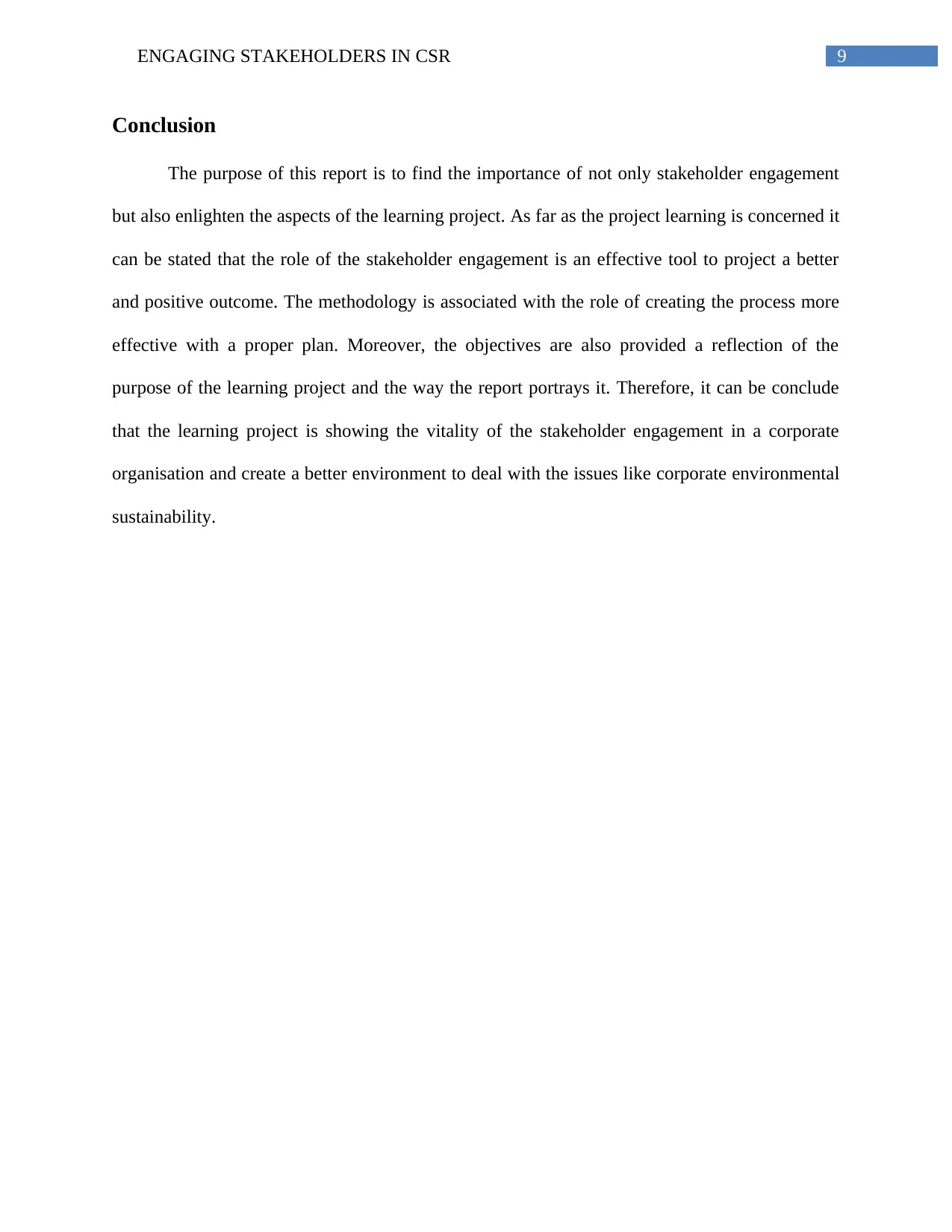
9ENGAGING STAKEHOLDERS IN CSR
Conclusion
The purpose of this report is to find the importance of not only stakeholder engagement
but also enlighten the aspects of the learning project. As far as the project learning is concerned it
can be stated that the role of the stakeholder engagement is an effective tool to project a better
and positive outcome. The methodology is associated with the role of creating the process more
effective with a proper plan. Moreover, the objectives are also provided a reflection of the
purpose of the learning project and the way the report portrays it. Therefore, it can be conclude
that the learning project is showing the vitality of the stakeholder engagement in a corporate
organisation and create a better environment to deal with the issues like corporate environmental
sustainability.
Conclusion
The purpose of this report is to find the importance of not only stakeholder engagement
but also enlighten the aspects of the learning project. As far as the project learning is concerned it
can be stated that the role of the stakeholder engagement is an effective tool to project a better
and positive outcome. The methodology is associated with the role of creating the process more
effective with a proper plan. Moreover, the objectives are also provided a reflection of the
purpose of the learning project and the way the report portrays it. Therefore, it can be conclude
that the learning project is showing the vitality of the stakeholder engagement in a corporate
organisation and create a better environment to deal with the issues like corporate environmental
sustainability.
Paraphrase This Document
Need a fresh take? Get an instant paraphrase of this document with our AI Paraphraser
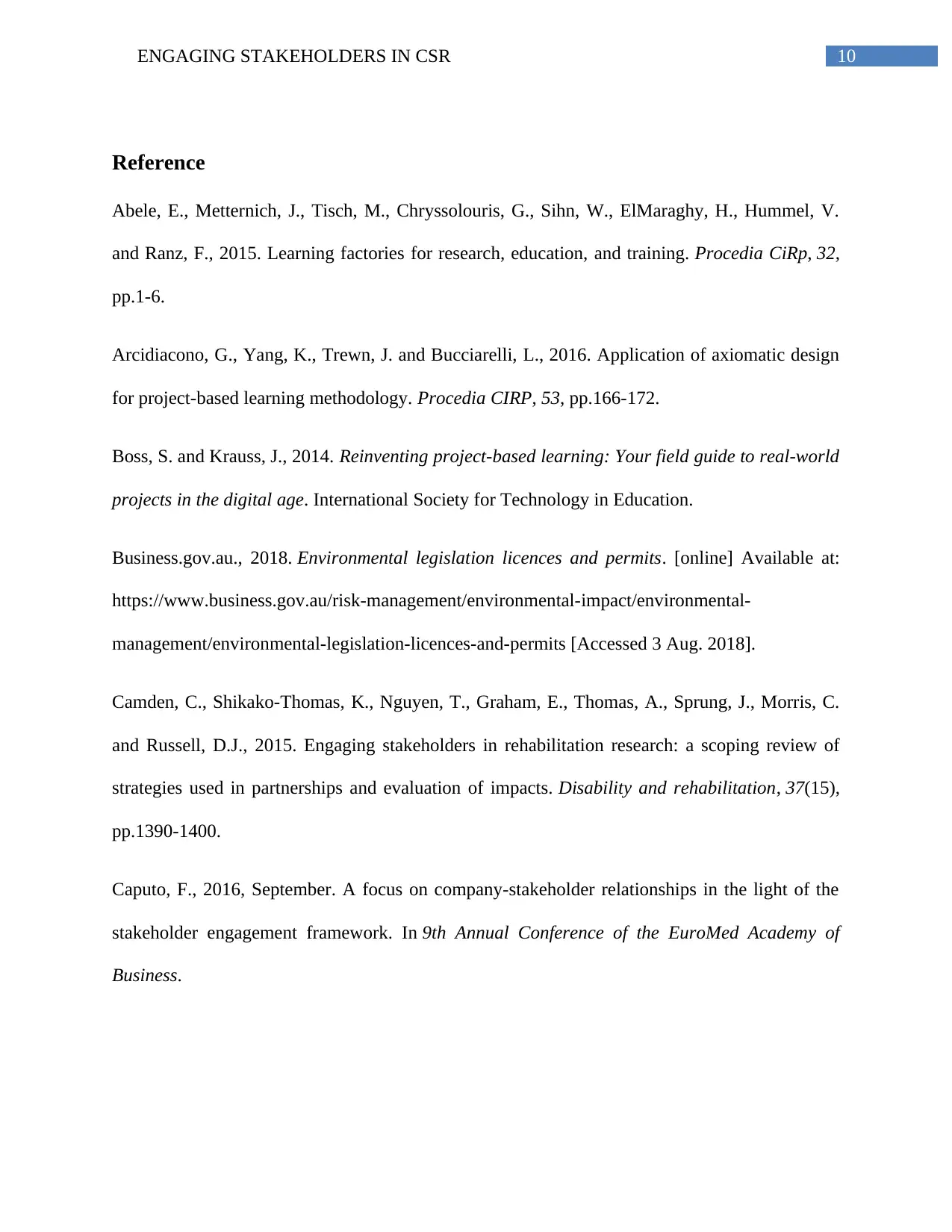
10ENGAGING STAKEHOLDERS IN CSR
Reference
Abele, E., Metternich, J., Tisch, M., Chryssolouris, G., Sihn, W., ElMaraghy, H., Hummel, V.
and Ranz, F., 2015. Learning factories for research, education, and training. Procedia CiRp, 32,
pp.1-6.
Arcidiacono, G., Yang, K., Trewn, J. and Bucciarelli, L., 2016. Application of axiomatic design
for project-based learning methodology. Procedia CIRP, 53, pp.166-172.
Boss, S. and Krauss, J., 2014. Reinventing project-based learning: Your field guide to real-world
projects in the digital age. International Society for Technology in Education.
Business.gov.au., 2018. Environmental legislation licences and permits. [online] Available at:
https://www.business.gov.au/risk-management/environmental-impact/environmental-
management/environmental-legislation-licences-and-permits [Accessed 3 Aug. 2018].
Camden, C., Shikako-Thomas, K., Nguyen, T., Graham, E., Thomas, A., Sprung, J., Morris, C.
and Russell, D.J., 2015. Engaging stakeholders in rehabilitation research: a scoping review of
strategies used in partnerships and evaluation of impacts. Disability and rehabilitation, 37(15),
pp.1390-1400.
Caputo, F., 2016, September. A focus on company-stakeholder relationships in the light of the
stakeholder engagement framework. In 9th Annual Conference of the EuroMed Academy of
Business.
Reference
Abele, E., Metternich, J., Tisch, M., Chryssolouris, G., Sihn, W., ElMaraghy, H., Hummel, V.
and Ranz, F., 2015. Learning factories for research, education, and training. Procedia CiRp, 32,
pp.1-6.
Arcidiacono, G., Yang, K., Trewn, J. and Bucciarelli, L., 2016. Application of axiomatic design
for project-based learning methodology. Procedia CIRP, 53, pp.166-172.
Boss, S. and Krauss, J., 2014. Reinventing project-based learning: Your field guide to real-world
projects in the digital age. International Society for Technology in Education.
Business.gov.au., 2018. Environmental legislation licences and permits. [online] Available at:
https://www.business.gov.au/risk-management/environmental-impact/environmental-
management/environmental-legislation-licences-and-permits [Accessed 3 Aug. 2018].
Camden, C., Shikako-Thomas, K., Nguyen, T., Graham, E., Thomas, A., Sprung, J., Morris, C.
and Russell, D.J., 2015. Engaging stakeholders in rehabilitation research: a scoping review of
strategies used in partnerships and evaluation of impacts. Disability and rehabilitation, 37(15),
pp.1390-1400.
Caputo, F., 2016, September. A focus on company-stakeholder relationships in the light of the
stakeholder engagement framework. In 9th Annual Conference of the EuroMed Academy of
Business.
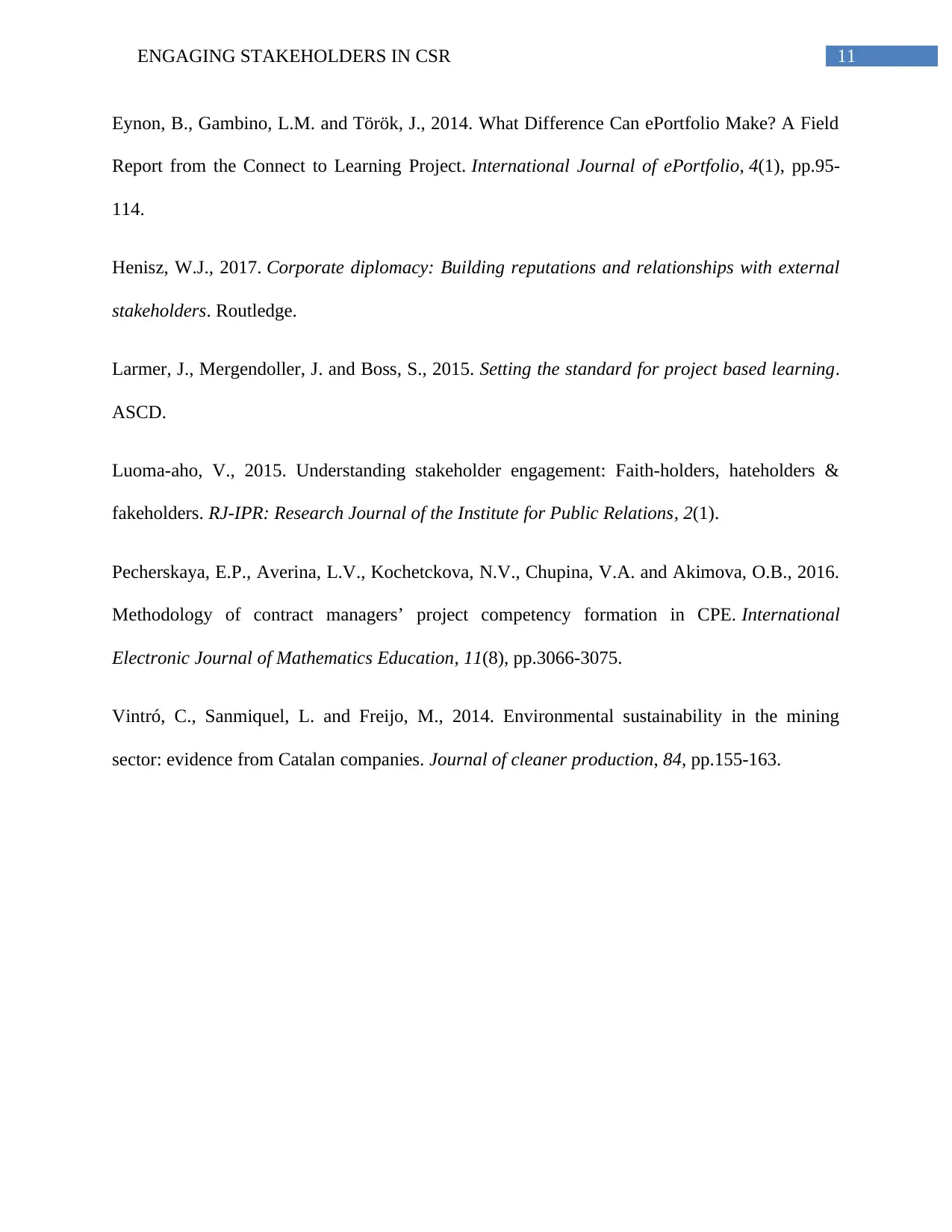
11ENGAGING STAKEHOLDERS IN CSR
Eynon, B., Gambino, L.M. and Török, J., 2014. What Difference Can ePortfolio Make? A Field
Report from the Connect to Learning Project. International Journal of ePortfolio, 4(1), pp.95-
114.
Henisz, W.J., 2017. Corporate diplomacy: Building reputations and relationships with external
stakeholders. Routledge.
Larmer, J., Mergendoller, J. and Boss, S., 2015. Setting the standard for project based learning.
ASCD.
Luoma-aho, V., 2015. Understanding stakeholder engagement: Faith-holders, hateholders &
fakeholders. RJ-IPR: Research Journal of the Institute for Public Relations, 2(1).
Pecherskaya, E.P., Averina, L.V., Kochetckova, N.V., Chupina, V.A. and Akimova, O.B., 2016.
Methodology of contract managers’ project competency formation in CPE. International
Electronic Journal of Mathematics Education, 11(8), pp.3066-3075.
Vintró, C., Sanmiquel, L. and Freijo, M., 2014. Environmental sustainability in the mining
sector: evidence from Catalan companies. Journal of cleaner production, 84, pp.155-163.
Eynon, B., Gambino, L.M. and Török, J., 2014. What Difference Can ePortfolio Make? A Field
Report from the Connect to Learning Project. International Journal of ePortfolio, 4(1), pp.95-
114.
Henisz, W.J., 2017. Corporate diplomacy: Building reputations and relationships with external
stakeholders. Routledge.
Larmer, J., Mergendoller, J. and Boss, S., 2015. Setting the standard for project based learning.
ASCD.
Luoma-aho, V., 2015. Understanding stakeholder engagement: Faith-holders, hateholders &
fakeholders. RJ-IPR: Research Journal of the Institute for Public Relations, 2(1).
Pecherskaya, E.P., Averina, L.V., Kochetckova, N.V., Chupina, V.A. and Akimova, O.B., 2016.
Methodology of contract managers’ project competency formation in CPE. International
Electronic Journal of Mathematics Education, 11(8), pp.3066-3075.
Vintró, C., Sanmiquel, L. and Freijo, M., 2014. Environmental sustainability in the mining
sector: evidence from Catalan companies. Journal of cleaner production, 84, pp.155-163.
⊘ This is a preview!⊘
Do you want full access?
Subscribe today to unlock all pages.

Trusted by 1+ million students worldwide
1 out of 12
Related Documents
Your All-in-One AI-Powered Toolkit for Academic Success.
+13062052269
info@desklib.com
Available 24*7 on WhatsApp / Email
![[object Object]](/_next/static/media/star-bottom.7253800d.svg)
Unlock your academic potential
Copyright © 2020–2025 A2Z Services. All Rights Reserved. Developed and managed by ZUCOL.





